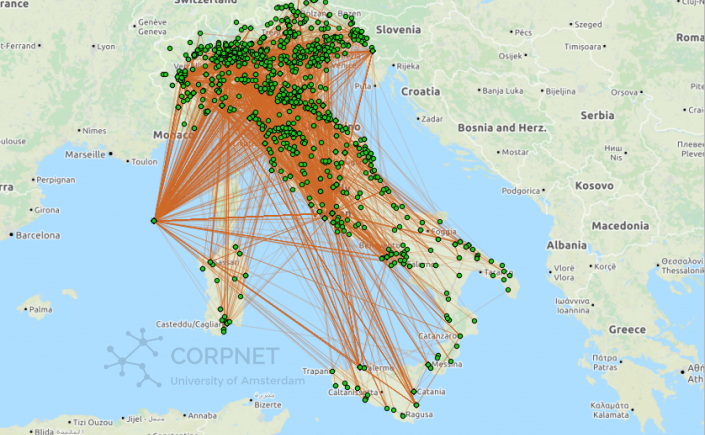A new (Dutch) blog by the CORPNET group has been posted on Stuk Rood Vlees. The piece, ‘Brexit en de verdeeldheid van het Britse Old Boys netwerk’, is written by Frank Takes and Eelke Heemskerk and can be found here.
Brexit Through the Lens of Network Science: The Position of the UK and London in the Global Corporate Network
In this blog post we look at the United Kingdom and London from a network perspective, investigating the connectedness of British corporations in the global network of corporate control. The aim is to give an alternative and/or complementary “social network analysis”-perspective for the lively discussions on a possible Brexit, here focusing on data related to corporate power and control.
Introduction
Brexit, the possible withdrawal of the United Kingdom from the European Union, is a frequently debated topic. A “yes” as outcome of the June 23 referendum is likely to be of substantial influence on the global economic system. A lot of the debates on Brexit are centered around arguments based on economic impact in terms of trade, manufacturing, import/export, foreign investment, etc. Throughout this blog article, we look at the UK from the perspective of Britain’s corporate elite network, investigating the position of the UK within the global corporate elite network. Firms are not individual market actors, but are typically embedded in dense networks of power and control, for example based on ownership or interlocking directorates. The CORPNET research group at the University of Amsterdam studies these networks as part of a five-year research programme funded by the European Research Council (ERC). The general idea behind the group’s so-called “network science“-approach is that by studying a system of interaction (the global economy) rather than mere sums and averages of the systems’s individuals (economic activity and behavior of corporations/countries), we obtain new insights in the considered system.
Position of the UK and London
Early 2016, our research group studied the organization of the global corporate elite from a network perspective. We visualized the relationships between cities across the globe based on whether the firms in these cities were involved in board interlocks: shared senior level directors between firms. To learn more about the substantial body of literature on the causes and consequences of interlocks, see the excellent survey article by Mark Mizruchi.
We obtain a tightly connected so-called city network consisting of 24,747 cities (the nodes), connected through 874,810 distinct board interlock ties (the ties). The strict center of this network, consisting of the 409 (1.65%) most well-connected cities across the globe, is shown in Figure 1. In this figure, a node (object) represents a city, the color of an object corresponds to the country, and the size of a node is based on how central this node is with respect to the other nodes, based on the structure of the network. Betweenness centrality is a network metric that indicates how often a node is on a shortest path between other nodes. It measures the brokerage position of that node, in our city network corresponding to a city’s contribution to connecting other cities across the globe.

It is evident that London has by far the most dominant position in this network. Globally, London plays a crucial role in connecting the global corporate elite through short path lengths. Furthermore, we note that in general there is a large number of British cities (albeit as a result of London’s central position) present in the center of this network. More specifically, even though only 723 (2.9%) of the cities in the global network of 24,747 cities are in the United Kingdom, 69 (16.9%) of the cities in the small center of 409 cities is British. This demonstrates how on average the UK cities are nearly 6 times more dominant in the center of the network than an average country’s cities.
The United Kingdom, and in particular London, is indeed at the heart of the world’s corporate elite. London is not only a gatekeeper through which the United Kingdom is connected with the rest of the world, but also connects the European mainland’s corporate elite to for example the United States, the East and the former British Commonwealth countries. It is often argued that in general, The City is in largely favor of staying in the EU (see for example this survey by CSFI). Contrary, Brexit advocates claim that Britain is a well-developed and globally integrated country that can stand on its own within the global economy, without the need of the European Union. But compared to Europe, how divided is the UK itself? Does it indeed have one well-organized and connected corporate structure?
Community detection
To answer the above mentioned question, we will again “consult” the network, and attempt to derive communities from the city network based on board interlocks. We identify groups of nodes (cities) that are more tightly connected with each other, than with the rest of the network. Community detection is a well-known method from the field of network science that allows one to find these densely connected groups of nodes in the network, based only on the structure of the network, so without any prior knowledge rather than the network’s connections. Here we use modularity maximization using the Louvain method, a well-known computationally efficient technique for finding communities that by swapping nodes between communities tries to optimize the modularity value indicating the quality of the division of the network into communities. If we use this algorithm on the aforementioned global city network and focus on Europe, we get the division of cities into communities as indicated by the colors in Figure 2.

From Figure 2, we can observe that a number of communities spanning multiple countries are found by the algorithm: there is a community of Germany, Switzerland, Austria, Hungary and former Yugoslavian countries, a community of cities in the “Benelux” countries (Belgium, Netherlands, Luxembourg), a community of Southern-European countries including France, Spain and Italy (but not Portugal, which is more strongly connected to Brazil and Latin America, not visualized here). The Czech Republic and Slovakia form a tight community, and so do the Scandinavian countries, except for Finland which is apparently more tightly connected in a community with Estonia. Poland’s cities do not clearly belong to any particular community, and are mixed between the communities around Russia, Germany and Scandinavia. Interesting and worthy to note here is that no information on the geography of Europe was put into the community detection algorithm. The results are purely derived from the structure of the corporate elite through board interlocks.
Turning to the UK; in Figure 2 we see how British cities appear to be in a community together with Ireland, seemingly posing as a whole. It should be noted that a fair share of the board interlocks also occurs between firms within cities, resulting in so-called self-loops in the networks. In particular, London has an extraordinary strong self-loop, as the City houses a large number of firms that interlock with each other, creating a tie that is stronger than any other tie. One way of looking at these self-loops is to say that they somehow indicate the internal power structure of a city. Interestingly, if in the global city network we search for communities in the network with these self-loops, the British business community falls apart into a a total of 19 separate communities, as shown in Figure 3, separating London from the rest of the UK. The resulting communities have a clear regional character, and are no longer as well-connected as they were with London’s integrative power. This suggests that there may be substantial consequences for the international connectedness of certain regions of the UK, should the Brexit somehow lead to a particular separation of these regions from The City.

Final remarks
Based on these results, one could say that internally, the UK is perhaps as divided as the European Union itself, i.e., it may not want to overestimate its unity. At least the corporate elite in the UK itself is strongly regionally oriented, albeit overshadowed by the integrative power of The City. Of course it remains to be seen what the precise consequences are of a Brexit on a corporate system such as the one considered in this blog post. Nevertheless, given the key position of London and the UK in the global network, it is likely that local changes in the corporate structure of firms in the UK can significantly influence both the UK as well as the global system as a whole, given the dominant position of, in particular, the city of London.
Apart from the results obtained above for the United Kingdom, we hope that this short blog post provides some insight in how network science is able to reveal patterns that are not directly visible from studying the data objects themselves, but are evident in the network perspective. Within the CORPNET group of the University of Amsterdam, we are constantly trying to find new patterns, phenomena, methods and ideas to specifically understand corporate network structures. Want to know more about this research, the data and specifics about the city network construction and analysis? See our latest paper (from which the text above was largely derived):
- E.M. Heemskerk, F.W. Takes, J. Garcia-Bernardo and M.J. Huijzer. Where is the global corporate elite? A large-scale network study of local and nonlocal interlocking directorates. Forthcoming in Sociologica, 2016. arXiv:1604.04722
Interested in learning more about the CORPNET group? Do feel free to contact us!
 This blog post was written by Frank Takes, postdoctoral researcher in the CORPNET group at the University of Amsterdam.
This blog post was written by Frank Takes, postdoctoral researcher in the CORPNET group at the University of Amsterdam.
CORPNET data in Harvard Business Review: “How Corporate Boards Connect, in Charts”
Everyone knows that large companies share board members, but it’s hard to appreciate just how enmeshed global governance has been for decades until you see the connections…
Continue reading this post in Harvard Business Review: How Corporate Boards Connect, in Charts.
Sunbelt 2016 presentations available online
The CORPNET team enjoyed the Sunbelt 2016 conference, attending many great presentations and meeting a number of interesting new and old colleagues and friends. Slides of the presentations given by our group members can be found below.
- Frank Takes: Centrality in the Global Network of Corporate Control
- Eelke Heemskerk: Where is the global corporate elite? A large-scale network study of local and non-local interlocking directorates
- Javier Garcia-Bernardo: Data quality in interlocking directorates
See you at Sunbelt 2017!
Two PhD positions on corporate control and network analysis
Two fully funded PhD positions are available at CORPNET, University of Amsterdam.
Closing date 1 May. Starting date (no later than) 1 september 2016.
We’re a multidisciplinary team, bringing together political science, computer science, network science, sociology, and based at the Amsterdam Insitute for Social Science Research. We’re interested in networks of corporate control. See https://corpnet.uva.nl
For the first position, we are looking for somebody with experience in longitudinal / dynamic network analysis . For the second position, we are looking for somebody with corporate governance expertise, ideally from a networked perspective.
Follow the links below for more information, or see https://corpnet.uva.nl. Contact Eelke Heemskerk (e.m.heemskerk@uva.nl) for more information.
Corporate Network Governance: Power, Ownership and Control in Contemporary Global Capitalism (CORPNET)
CORPNET seeks to do what has so far eluded existing scholarship: to fully explore the global network of corporate ownership and control as a complex system. Using cutting-edge network science methods, the project explores for the first time the largest database on ownership and control covering over 100 million firms. Exploiting the longitudinal richness of the new data in combination with state-of-the-art methods and techniques makes it possible to model and empirically test generating mechanisms that drive network formation.
PhD Project: What Drives Network Formation?
This subproject studies the generating mechanisms that drive the formation of corporate governance networks. The project builds a conceptual framework that tries to explain the formation and (dis)continuation of corporate board overlap through the strategies of the actors involved. It takes a bipartite approach and starts from the notion that the generating strategies of actors do not only take place at the firm-by-firm level but are essentially located at the firm-by-person level. The methodological approach is temporal modelling (for example, stochastic actor-oriented or temporal exponential random graph models), and the project will have to develop methods and algorithms to apply modelling on a very large scale.
PhD Project: Corporate Control in Contemporary Global Capitalism
This project engages in a fundamental discussion on the relationship between corporate control, ownership and corporate power. In a world of dispersed and fragmented ownership, corporate directors and managers are the more powerful actors. In a world of (re)concentrated ownership however, directors lose power and influence. The question, then, is the extent to which new concentrated owners such as states and large asset managers, and the corporate elite of directors are separable entities. This is an important question with regard to financial intermediaries and for venture capital, but also for the re-emergence of the state as corporate owner in the global economy. Where and how do the network ties of ownership and of managerial control reinforce each other? Are ownership ties an additional tool for the corporate elite to strengthen their grip on big business? Or can we discern opposing groups of corporate managers and directors on the one hand and the (new) owners of corporate capital on the other?
The financial collapse and the impact on corporate elites

The 2008 financial collapse posed the biggest challenge to the global economy since the Great Depression. Unlike the 30’s the global economic governance system survived. A study of the University of Amsterdam explains how. The results are published in the journal ‘Global Networks’, Eelke Heemskerk, Meindert Fennema (UvA) and William K. Carroll (University of Victoria) show that global actors did not withdraw into their national business communities after the financial crisis. Instead of securing one’s particular (national) interest, as happened in the 1930’s, corporate elites sought consensus. At all costs a collapse of the world financial system had to be avoided.
GESIS presentation on data quality, communities and centrality in big corporate network analysis
The slides of our presentation at the GESIS Computational Social Science Wintersymposium on December 3 in Cologne, Germany, are now available.
If you have any questions about our talk, send us an e-mail!
CORPNET participates in new initiative to examine fossil fuel networks in Western Canada
Who is steering fossil fuel extraction in Western Canada and what influence do they wield? These central questions are driving a six-year research and public engagement initiative, Mapping the Power of the Carbon-Extractive Corporate Resource Sector, with funding from the Social Sciences and Humanities Research Council (SSHRC). The project brings together researchers, civil society organizations and Indigenous participants to study the oil, gas and coal industries in British Columbia, Alberta and Saskatchewan. CORPNET is an international partner and co-investigator in the project.
Hosted by the University of Victoria, the partnership is jointly led by the university, the Canadian Centre for Policy Alternatives (BC and Saskatchewan offices) and the Parkland Institute at the University of Alberta. In addition to the $2.5-million SSHRC award, the project is also supported by $2 million in matching contributions. (Please see backgrounder for further details on funding contributions and participants.)
“We’ve seen a rapid acceleration of fossil fuel extraction in recent years,” says Dr. Bill Carroll, UVic professor of sociology and co-director of the partnership. “Yet our knowledge of the companies involved and how they influence decision-making about our publicly owned carbon resources is remarkably sparse.”
“Our research will help Canadians gain a clearer picture of who’s-who in this increasingly important sector of Canada’s economy,” says Shannon Daub, who co-directs the partnership on behalf of CCPA-BC.
The partnership’s work will focus in four key areas:
• A systematic mapping of how the carbon-extractive industry is organized—which companies are involved, who runs them, who owns them and how they connect to broader international corporate networks.
• Analysis of the sector’s influence on public debates and policy making—such as efforts to secure social license, and corporate links to governments, political parties, lobby groups and private foundations.
• Case studies of contentious “flashpoints”—such as the expansion or development of new mines, pipelines, oil fields or export facilities.
• Development of an open source, publicly accessible corporate database—along with a training program for citizens and civil society groups, many of whom will contribute and update data.
https://www.policyalternatives.ca/node/13239
http://communications.uvic.ca/releases/release.php?display=back&id=227
Centrality Measures applied to Italy’s Corporate Network
This post is the first in a series of blog posts aimed at a broad academic audience, giving an example of the work done in the CORPNET group. These posts are not meant as full self-contained scientific articles, but merely serve to illustrate the type of research done in our group.
The following post is about the board interlock network of Italy, and what network modelling can tell us about the connectedness of the Italian economy, specifically paying attention to the difference between the north, center and south of the country. Techniques from the field of network analysis are used, including component analysis and centrality measures. This blog post was written by master student Roberto Lucchese as part of an explorative analysis of the corporate network of Italy.
Centrality Measures applied to Italy’s Corporate Network
Roberto Lucchese
Here we study the corporate network of Italy in an attempt to acquire more knowledge and understanding of its topological, structural and complex properties.
Why a network approach?
Network science is an increasingly important field into the study of so-called complex systems. Everything, potentially, could be translated into a network model. Railway routes and stations, financial transfers and electric power distribution are just a few examples. Using a network approach we are able to transpose very complex systems and problems into understandable and easy to analyze models of objects (nodes) and relationships between these objects (called edges). In this work, we model companies or firms as nodes, whereas edges represent a shared board member between these companies.

The Italian corporate board network
The image on top of this post and Figure 1 above show our corporate board network, specifically its giant component, being the connected component containing the largest fraction of nodes. Or, in other words, the largest subset of companies that are (indirectly) connected with each other. In Figure 1 the actual skeleton of the network is shown. Each node represents a company and (weighted) edges between them represent the directors they share. Two companies sharing four directors, for example, will be described by two nodes linked by an edge with weight four. We also assign a color to every node representing its geolocation inside the Italian territory, namely: in blue we represent companies located in northern regions, in red we represent companies located in central regions and in green companies in southern regions (including Sardinia and Sicily). In the image on top of this post, the skeleton of the network was projected into an interactive OpenStreetMap. Companies for which the city was unknown have been purposely located in the Tyrrhenian Sea, close to the west coast of Corsica.
In order to create this network, we extracted from a 2013 snapshot of the Orbis database all 37,569 Italian companies, registered as “large” or “very large” and as “active”. Also, only companies for which information was available about the senior directors (board of directors, executive board, supervisory board or senior management) were selected.
Dataset and giant component
Figure 2 presents the size of the dataset we study. We notice how the percentage of edges in the giant component is high with respect to the percentage of nodes. Indeed, almost the 50% of the interlocks belong to the giant component of the network while only the 12% of companies are included. From this, one can see how companies inside the giant component, that represent the largest connected sub-economy, are really strongly connected and the phenomenon of the so-called lobby of directors is clearly noticeable. For the definition of lobbies we refer to the work of Caldarelli and Vespignani’s [1] where a “subset of directors of a boards who co-serve on an outside board together with a director of the present board” is called a lobby.
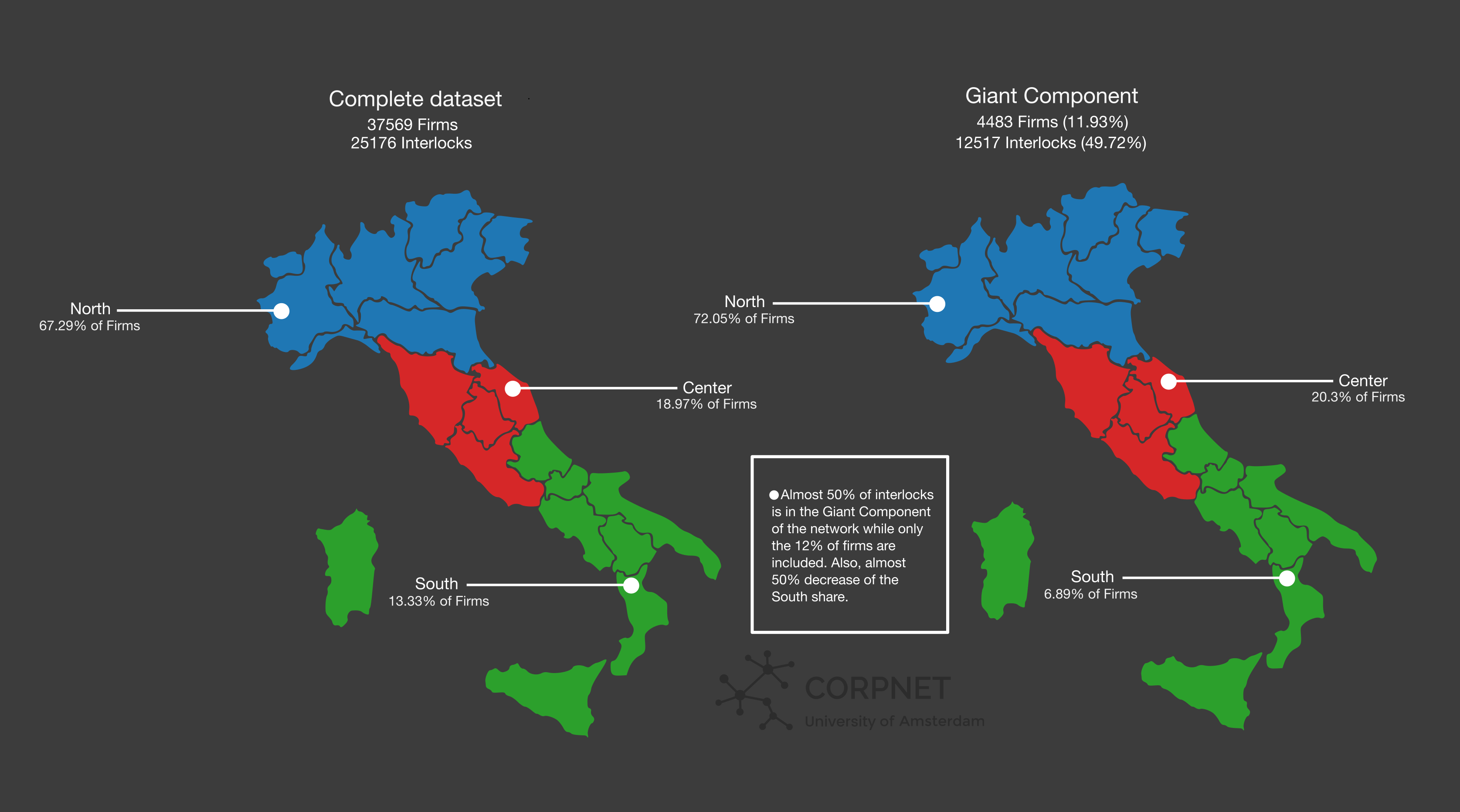
It is also worth to notice from Figure 2 how going from the complete dataset to the giant component network, the share of the companies belonging to the South of the country decreases by almost 50%.
In Figure 3 the network containing only connected components is also presented. In this network, companies that do not share any directors have been filtered out. Here, one should notice how going from the complete dataset, containing about 37,000 companies, to the “connected components“ network, containing about 16,000 companies, the number of nodes decreases drastically as all unconnected firms are filtered out. A reduction of almost 57% of the companies.

From this result we can easily see how unconnected businesses still represent a significant part of the country’s economy. One hypothesis is that many of these are “family-run” businesses, where directors sits only in one board.
Is the Giant Component also the main sub-economy?
In order to answer this question we run the following experiment: we take from the complete dataset, with about 37,000 companies, only the top 4483 (exactly the giant component size) by ranking (the higher is the total revenue, the higher the ranking value) and we then again look at the percentage of companies that lay in the giant component. In other words, we want to generate a new network with the same amount of companies of the giant component network from the complete dataset and we want to see how many of those companies belong to the giant component.
From the results, that show how only the 33% of those “top-companies” are in the same giant component, we could state that the giant component is the largest connected sub-economy of the country for the number of companies, but it is not the main sub-economy based on revenue. Weakly connected and/or “family-run” businesses in the Italian territory are thus likely a significant part of the total economy.
Figure 4 shows the network of the aforementioned top 4483 firms. One can immediately see how the giant component’s companies are surrounded by the the weakly or unconnected companies.
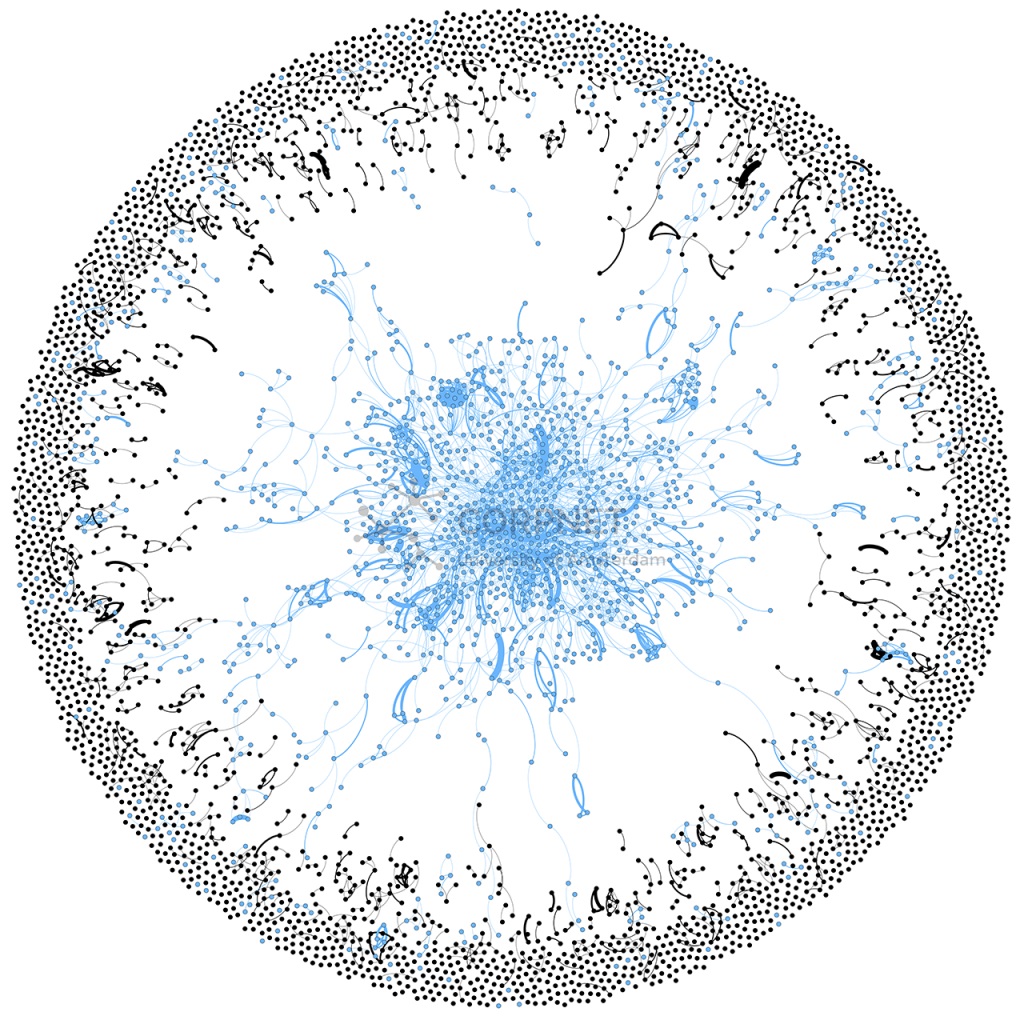
Component Analysis
But what happens outside the giant component? Are there other large components? In order to answer these questions we decided to study the second largest connected component, for which statistics are presented in the following table:
[table]
Description , Giant component, 2nd largest component
Nodes, 4483, 34
Edges, 12517, 53
[/table]
Looking at the numbers presented in this table, we can confirm that outside the giant component there is an high number of possibly family-run companies (or more in general, unconnected companies) and/or small clusters of companies. For this reason we decide to mainly focus on the giant component of our network. Despite this, some references and comparisons with the overall network and the connected components network will be made.
Betweenness Centrality
Centrality measures allow us to identify the most important nodes based on the structure of the network. Here, in particular, we use betweenness centrality, which assigns a value at each node proportional to the number of times that particular node is present in the shortest path between two other nodes. In this way we can easily see nodes that act as bridges within the network.
In Figure 5 we see the Italian board corporate network’s giant component, where the node size is proportional to its betweenness centrality. In particular, bigger size nodes are the ones for which the centrality value is higher. Also, colors are assigned to nodes based on the geolocation in which companies are based (North, Center or South).
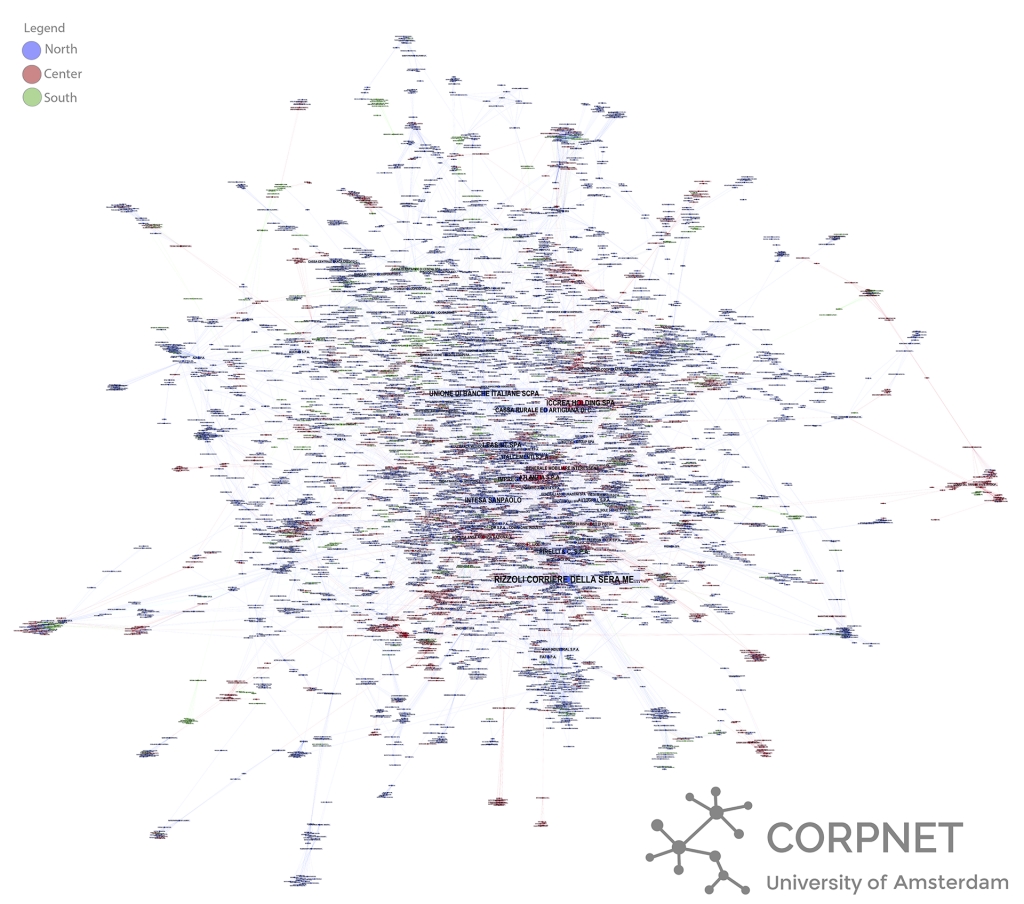
From the network above we isolated the Top-100 companies by revenue. The result is shown in Figure 6 below.
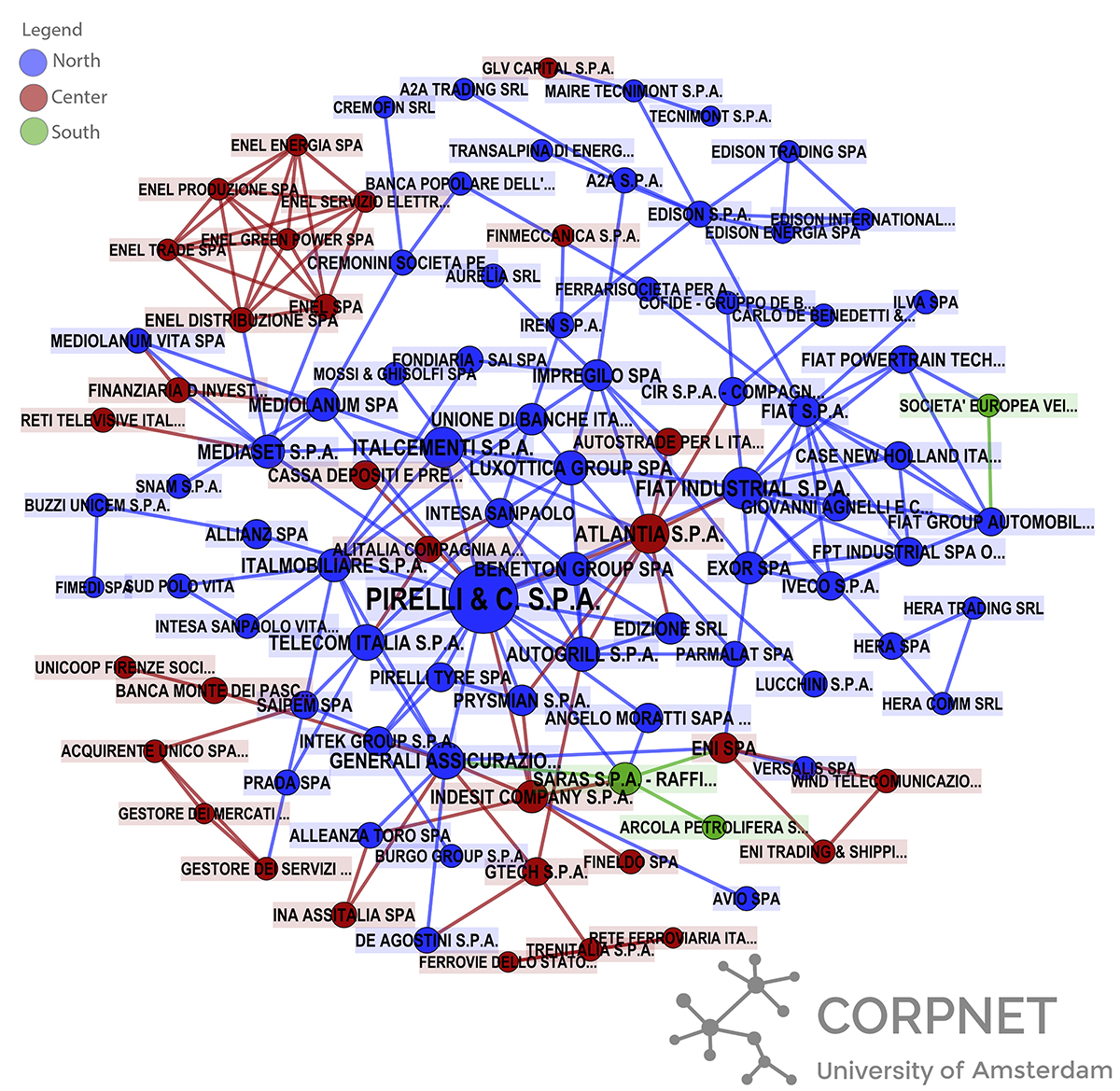
We notice that in both network visualizations the North of the country stands, most notably in Figure 6. An other important and also notable result is given by the percentage of the South present in the Top-100 network. Only the 3% of the companies from the south of the country take part in the elite (based on betweenness centrality) of the country. This could be due to different reasons. One possible reason is explained by Banca d’Italia in [2]: “By comparison with those in the Centre and North, Southern firms depend more on bank credit and have traditionally faced stiffer terms for access to it. This divergence reflects differences in the sectoral and size distribution of firms as well as differing conditions in the business environment.”
Differences between North, Center and Southern regions. Hypothetical reasons behind it.
What this still needs is a discussion of how the network describes power in the Italian corporate world. Vitali, Glattfelder and Battiston [3] studied ownership stakes held in firms by larger firms to establish where ‘control’ over their share values ultimately lay and it would be interesting to do the same here. One of their key findings was that 147 firms share control in at least the economic value of 30% of global trans national corporations. It is clear that the corporate power of Italy is in the North but with further analysis we might be able to say which companies or even individual people represent the most powerful positions in this network.
Looking only at the presence of large and very large firms there is clearly something dividing the north, centre and south of Italy. The causes and implications of this could be numerous and the potential interactions between them even more so, but at glace it is striking how closely the presence of large firms match the kingdoms of Italy before Italian unification. The contemporary reason is that firms have trouble gaining access to finance in souther regions of Italy, as mentioned above. However, if we ask what the causes of this are, it would be a plausible hypothesis that the regional political institutions of Italy have developed differently after the period of Italian unification.
Political institutions that support justice, the enforcement of contracts and education (to name a few factors) have been seen as the backbone of economic development. In a now famous global historical study Acemoglu and Robinson [4] explore the importance of these institutions and the effects ofvested political interests around them. They found that the presence or absence of ‘inclusive’ institutions during the colonial period correlated closely with the development of a country’s economy centuries later. While this approach has its critics (Boldrin, Levine and Modica [5]) it is possible that what we’re seeing here is an example of sub-national variations in political capital, stemming from institutional compromises in Italy around the formation of the state. This would explain why large firms and other indicators of economic development falls in the regions it does and would explain how it lasts over time.
It would be interesting to test this further but also suggests that the analysis of the database could have a surprising value to scholars of sub-national political economics.
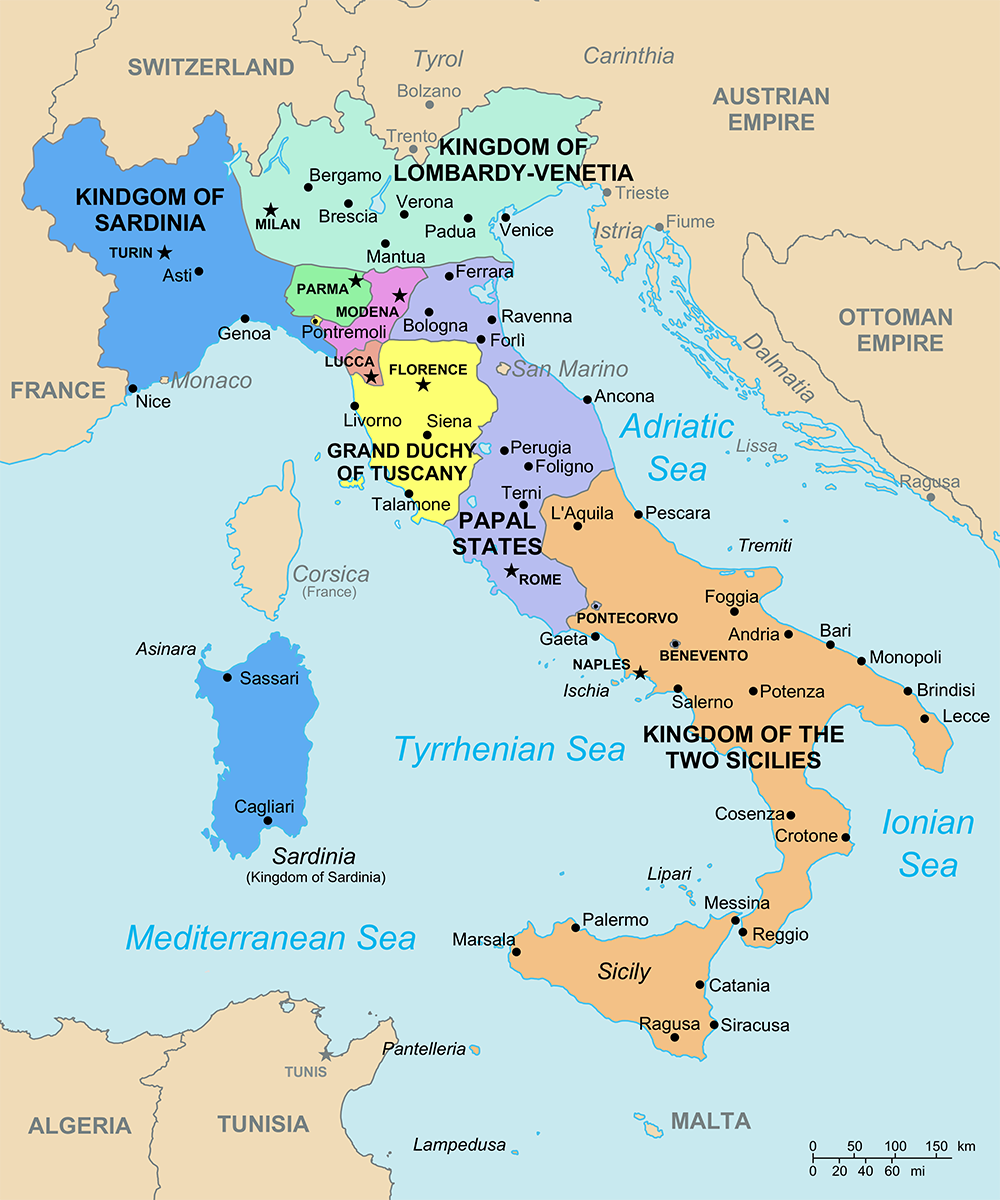
In future work we will further investigate the board interlock network of Italy in the context of centrality measures and community detection.
Acknowledgment
Thanks to Nicholas Hogan for contributions to the part on hypothetical reasons.
References
[1] Caldarelli and Vespignani – “Large Scale Structure and Dynamics of Complex Networks: From Information Technology to Finance and Natural Science”.
[2] Banca d’Italia – “The economy of the Italian regions”.
[3] Vitali Stefania, James B. Glattfelder, and Stefano Battiston. “The Network of Global Corporate Control.” PLoS one, 2011: 1-6.
[4] Acemoglu, Daron, and James A. Robinson. Why Nations Fail: The Origins of Power, Prosperity, and Poverty. New York: Crown Buisness, 2012.
[5] Boldrin, Michele, David K. Levine, and Salvatore Modica. A Review of Acemoglu and Robinson’s Why Nations Fail. California, 2012.
CORPNET gives plenary presentation at the CSS Winter Symposium in Cologne
We are glad to announce that the abstract “On Data Quality and Centrality Measures in Big Corporate Network Analysis” has been selected for a plenary presentation in the 2nd GESIS Computational Social Science Winter Symposium 2015.
Although often depicted as atomistic and individualistic market actors, corporations are tightly embedded in networks of power and control. They share board members (interlocking directorates), share owners and engage in direct shareholdings with one another. These so-called corporate networks have long formed distinct national business communities and are part of the organisation of national economies.
New databases and methods allow us to go beyond our current understanding of how the global economy is organised. However, with big corporate network data come big problems as well. In the CORPNET research group we analyse the networks of corporate control of more than 170 million companies and their directors (sourced from the ORBIS database). This rich data source provides both new methodological challenges when interpreting the result of applying for example centrality measures as well as challenges with respect to data quality assurance.
The abstract can be found here. See you in Cologne!





